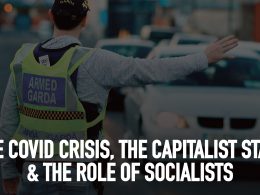The publication of James Connolly’s Labour in Irish History 100 years ago this year was a landmark in the development of a socialist and Marxist understanding of Irish history. In this book James Connolly sought to outline the key social struggles of Irish working people uniting all religions and to explain why the struggle for national liberation against British imperialism was inherently linked with these movements.
In the conclusion of the book Connolly pointed out that “the Irish working class remain as the incorruptible inheritors of the struggle for freedom in Ireland” and that the “whole long age-long fight of the Irish people against their oppressors resolves itself into a fight for the mastery of the means of life, the sources of production in Ireland”. For him, only a socialist movement of a united working class, could end the exploitation and oppression of the British capitalist class in Ireland and ultimately resolve the national question.
Despite writing in isolation, these ideas echo the theory of the permanent revolution that had been developed by Leon Trotsky in the aftermath of the 1905 revolution in Russia. Given that it was tied by a thousand strings through co-investments with landlordism and imperialism, Trotsky explained that Russian capitalism was both unable and unwilling to challenge the existing Tsarist social and political order in revolutionary struggle. The Russian capitalists also feared that this struggle would result in the working class challenging them in a struggle against poverty and for social and democratic rights. In this respect, James Connolly argued that the Irish capitalist class were no different to their Russian counter- parts – they too feared the struggles of the Irish working class and peasantry and in the last analysis would betray them.
One notable example that Connolly provides of this was during the reign of the parliament of Henry Grattan in the latter half of the 18th century. In response to the threat of a French invasion in 1778, the Irish Volunteers were formed. This force was to grow to 80,000 armed citizen soldiers and in 1882 it became a tool used by the Irish parliament, which sat in College Green, to extract the concession of free trade from the British parliament. However Grattan and his ilk quickly disassociated themselves from the volunteers when they demanded universal suffrage in electtions to the parliament. Connolly summed up what happened when the British authorities sought to disarm the volunteers: “the working men fought, the capitalists sold out, and the lawyers bluffed”.
An important lesson for today, that Connolly draws out in the book, is the common oppression and misery of Catholic and Protestant working people and how this would ultimately lead to common struggle. He points to the development of the Oakboys and Whiteboys in the 18th century where protestant and Catholic peasants began to struggle against landlordism. The ultimate expression of this was to find itself in the rebellion of 1798 led by the United Irishmen, a rebellion that was inspired by the ideals of the French Revolution of 1789. The defeat of the 1798 was followed by an uprising led by Robert Emmet in 1803. Connolly points to the key role played by the working class during the rebellion in places such as the Liberties in Dublin. He contrasts this with the treacherous role played by the capitalist establishment in Ireland in 1798 and quotes United Irishmen leader Henry Joy McCracken who, in the aftermath of the rebellion, wrote “These are the times that try men’s souls – you will, no doubt, hear a great number of stories respecting the situation of this county. Its present unfortunate state is entirely owing to treachery. The rich always betray the poor.” One of those who was to fight in suppressing the rebellion of 1803 was “the great Liberator”, Daniel O’Connell.
In a later chapter, Connolly is scathing in his assessment of O’Connell, clearly illustrating his anti-working class outlook. The latter was to support the reactionary Whig government when he was elected as an MP in the 1830s. He used this position to attack trade unions in Ireland and opposed legislation in 1838 which sought to shorten the hours worked by children. Again, when writing of the 1848 rebellion led by the Young Irelanders, he points to very real limitations of its middle class leadership. At the height of the famine, they refused to link the social struggles of the peasants in with the national struggle. In one instance, one of its leaders, William Smith O’Brien attacked peasants for felling trees in order to build barricades because they had not sought the permission of the landlords. Some of the key themes that Connolly develops in this socialist classic have enormous relevance for today for workers in Ireland and for the working class and oppressed who are seeking to end national oppression throughout the world. Despite all the rhetoric of the Celtic Tiger Irish capitalism has not overcome the historical weakness which Connolly described.
The rise in sectarianism in Northern Ireland shows the failure of the capitalist establishment to resolve the national question. Connolly wrote in Labour in Irish History “revolutions are not the products of our brains, but of ripe material conditions”.
The material conditions created by capitalism on this island will create the basis for the building of a workers movement based on the socialist ideas that Connolly defended throughout his life. Such a movement can end sectarianism, oppression and capitalism in Ireland. This is why the central ideas contained in this book can, and remain, a guide to action for the socialist movement today and why it is such a recommended read.












